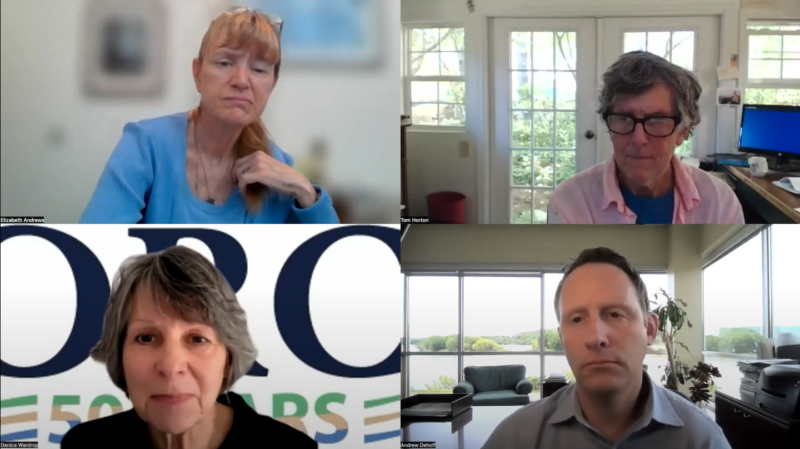Learning from Disaster: The Environmental Impacts and Lessons of Hurricane Agnes

Denice Wardrop, executive director of CRC, and Tom Horton, Chesapeake Bay Writer and Professor at Salisbury University, moderated the webinar with two expert speakers who provided unique perspectives on the environmental impacts of flooding. Drew Dehoff, Susquehanna River Basin Commission; and Elizabeth Andrews, Virginia Coastal Policy Center, William & Mary Law School, discussed lessons learned from previous disasters and the future of flood management.
Takeaways from the webinar
Drew Dehoff (Executive Director, Susquehanna River Basin Commission) develops comprehensive plans to prepare for future flooding occurrences in response to the increased susceptibility of the Susquehanna River Basin. The Susquehanna River Basin Commission was formed in 1971 and, one short year later, the organization faced the mass flooding of Hurricane Agnes. Currently, their goal is to enhance public welfare and education through flooding preparation rather than prevention.
- The commission secured funding to collaborate with federal agencies to enhance the flooding forecasting and warning system. Through the use of state of the art technology, forecasters are able to provide timely results and develop community tools which allow for residents to prepare.
- Also, in partnership with the federal government, the commission created a flood insurance map by denoting areas as a part of the 100 year flood plain. This map not only displays the one percent chance of flooding, but the series of possible stages which allows for individuals to listen to the forecast and match their appropriate response to it.
- The phenomenon of another hurricane similar to Agnes would cause dramatic impacts and devastation. There is the possibility that the basin would not withstand another catastrophic event.
- It is advised to continue restoring the natural function of our streams, waterways, watersheds, and wetlands while reducing sources of pollution to be more resilient to flooding.
Elizabeth Andrews (Professor of the Practice and Director, Virginia Coastal Policy Center, William & Mary Law School) was a child living in Northern Virginia when Hurricane Agnes struck. She witnessed the devastating effects of flooding on the property of her childhood home. During the webinar, Elizabeth talked about the influence that this experience had on her decision to work with coastal policies.
- Elizabeth grew up in the beltway on a few acres of hilly land with a natural, flowing creek that was a part of the Accotink Watershed. Elizabeth’s grandmother, Mary Perts, was an artist and admirer of nature. While the subject of her painting was the creek in the backyard which had experienced significant flood destruction, she chose to depict the chunks of concrete culvert that the county placed to stabilize the banks as boulders structures. It represented a new version of the creek, which had been forever transformed by human activity.
- Elizabeth stated that comprehensive planning is a key tool for connecting, engaging, and educating the community about flooding management. It allows for communities to plan future goals and receive feedback from residents.
- Green infrastructure provides co-benefits including water quality filtration, habitat, shoreline erosion control, and flood control.
- Cities like Hampton and Norfolk, are participating in the Dutch Dialogues Project. This teaches coastal cities how to live and thrive with water. Currently, Hampton is planning on relocating water to a canal that will double as an amenity for the community. This is an example of thinking creatively to expand flood management in combination with traditional hard infrastructure and wetland restoration.
Resources for further action
- Maggie Dunn, FEMA R3 Outreach Coordinator – Margaret.dunn@fema.dhs.gov
